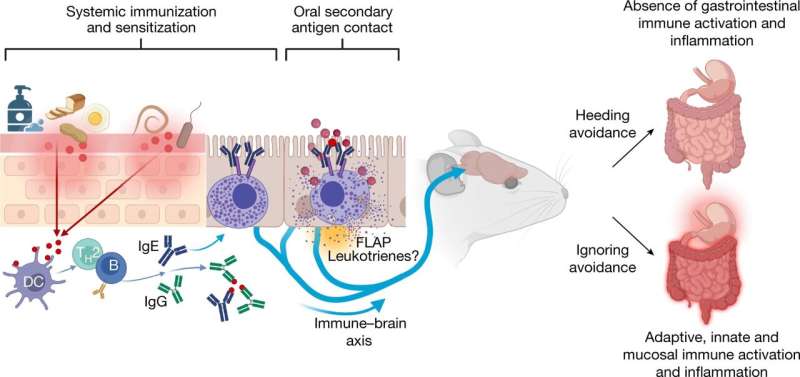This article has been reviewed according to Science X's editorial process and policies. Editors have highlighted the following attributes while ensuring the content's credibility:
fact-checked
peer-reviewed publication
trusted source
proofread
Mast cells as a sensor: Enigmatic immune cells help to avoid harmful allergens

The function of mast cells, which are part of the immune system, is still a mystery. Scientists at the German Cancer Research Center (DKFZ) have now shown that in mice mast cells function as a sensor that signals the animals to avoid antigens, including harmful allergens, which allow the mice to protect themselves from health-threatening inflammatory reactions. These findings were published in the journal Nature.
Mast cells are found primarily in tissues that separate the outside and inside worlds of the body, such as the epithelia of the gastrointestinal tract and lungs. Within the tissues, mast cells often reside near nerve endings. Mast cells are well known to persons suffering from allergies because they secrete messenger substances such as histamine, which cause annoying to health-threatening allergic symptoms. These symptoms occur when mast cells are activated by IgE class antibodies during repeated antigen contact.
"Why mast cells and IgE exist at all has not yet been conclusively explained," says Hans-Reimer Rodewald. The DKFZ immunologist and his team have now been able to show for the first time in mice, in a combination of behavioral experiments and immunological studies, that mast cells act like a sensor that helps to avoid contact with allergens.
No antigen avoidance without mast cells and IgE
The DKFZ researchers immunized mice with the allergen ovalbumin, a protein component of chicken egg white. They then gave the animals the free choice of preferring either normal or egg white-containing drinking water. Immunized animals avoided the egg white-enriched water, while their non-immunized conspecifics clearly preferred it. A large proportion of the immunized animals avoided the egg white-containing water already one day after immunization, some mice even after the first sip.
However, when the scientists performed this behavioral test with mice that genetically lack mast cells, both immunized and non-immunized animals preferred the egg white-containing water. Mice genetically unable to produce IgE also showed no avoidance behavior. Thus, both components—mast cells and IgE—are responsible for antigen avoidance.
When the immunized mice had no choice because the egg white solution was instilled in them, the animals developed inflammation in the stomach and small intestine. "The avoidance behavior mediated by mast cells apparently protects the animals from harmful immune reactions," explains Thomas Plum, one of the first authors.
How do mast cells 'talk' to the brain?
An important open question for the scientists was now: How can mast cells, as a component of the immune system, influence behavior? In what ways do immune cells "talk" to the brain? The scientists examined a variety of biologically active substances released by mast cells. These include leukotrienes, pro-inflammatory messengers known to activate sensory nerves.
If the researchers blocked leukotriene synthesis, the immunized mice no longer showed the same consequence in avoiding egg white. Leukotrienes therefore appear to be at least partly involved in avoidance behavior. Further immunological and neurobiological experiments are needed in the future to identify the nerve connections through which the mast cell signal is reported to the brain.
"In the intestine, lungs or skin, immune reactions against non-infectious antigens can occur as a result of so-called barrier disorders, permeability of the tissues from the outside to the inside. In the case of allergy, we call such antigens allergens. Whether these substances are dangerous or not, it is important for the organism to avoid their further intake in order to prevent inflammatory diseases. This is an evolutionary advantage and finally a conclusive explanation of the physiological role of mast cells and IgE," Rodewald says.
Whether mast cells also contribute to the avoidance of harmful antigens in humans must be addressed in further studies.
More information: Thomas Plum et al, Mast cells link immune sensing to antigen-avoidance behaviour, Nature (2023). DOI: 10.1038/s41586-023-06188-0


















